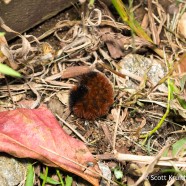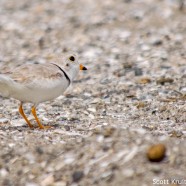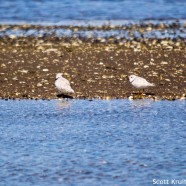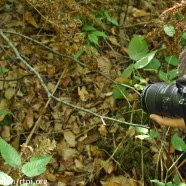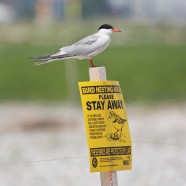Banded Woolly Bear
This Banded Woolly Bear caterpillar (Pyrrharctia isabella) had already gone into defensive mode, balling up after I spotted it and before I returned with my camera. I will say one thing for this individual – I love the look! The old story goes that more extensive black covering the body means it will be a colder and snowier winter will be for us, and the more brown a caterpillar has the warmer it will be. Even though it is not stretched out you can see how much brown we have here, and I like it! I think we could all go for a warmer winter than the last two historically cold seasons. I...
Read MorePiping Plovers in the Sand
This warm week has jump started breeding as Piping Plover pairs are getting much more focused on nesting, making scrapes and exhibiting soon to be parents behavior on some Connecticut beaches. Our Audubon Alliance for Coastal Waterbirds crew is wrapping up helping the Connecticut Department of Energy and Environmental Protection in placing string/psychological fencing and signage on major beaches and busy breeding areas. We will soon be assisting them in placing exclosures over Piping Plover nests to protect the precious eggs from predators on the ground (cats, raccoons, foxes and coyotes)...
Read MoreSlow Piping Plovers
This year has been rather cold – talk about news you did not need to know, huh? Even though temperatures have been much closer to average in recent days there is still not a lot of action on the breeding birds front, with these distant looks at Piping Plovers feeding in the middle of a marsh on a chilly, windy morning yesterday showing they are not nesting yet. Nights with lows near freezing will keep eggs at bay for the moment, but we at the Audubon Alliance for Coastal Waterbirds continue to be extremely busy putting up fencing and signage, reporting migrants, recording pairs and...
Read MoreFrightened snakes
Here’s Twan photographing one of the Timber Rattlesnakes (Crotalus horridus) we recorded during survey work this September. In this particular case we have a young male on the hunt for prey. It did not move from this position and it hoped that we would never notice it (and the snake is a heck of a lot easier to see when you know it’s there than when searching in the field!) I initially spotted it from where we were standing in the photo. It felt comfortable enough to simply remain still and rely on its natural camouflage which works phenomenally. However, other rattlesnakes that...
Read MoreCommon Tern (Sterna hirundo)
Sean found this Common Tern (Sterna hirundo) hard at work conducting beach stewardship and outreach on its own yesterday.
Read More



